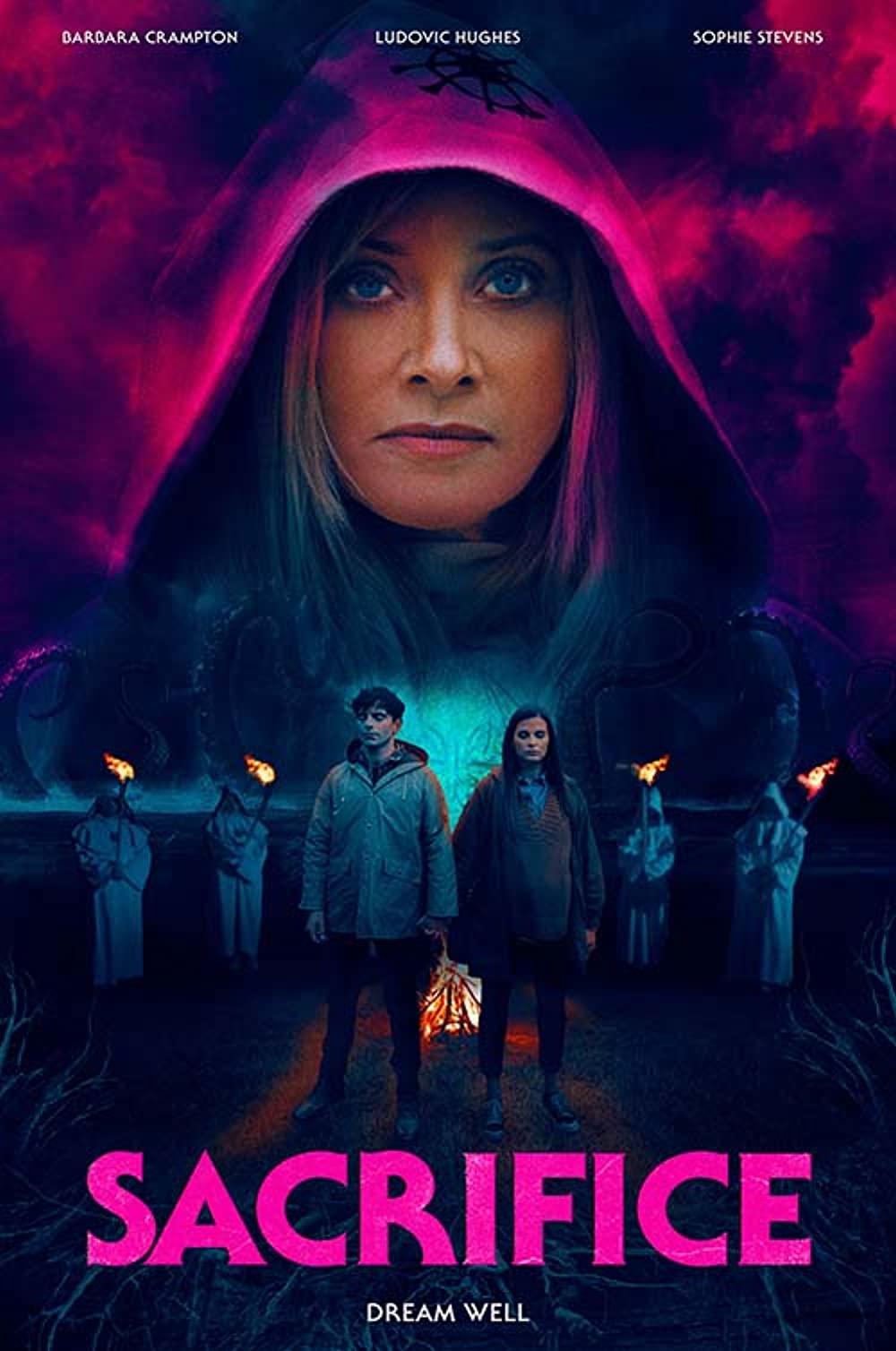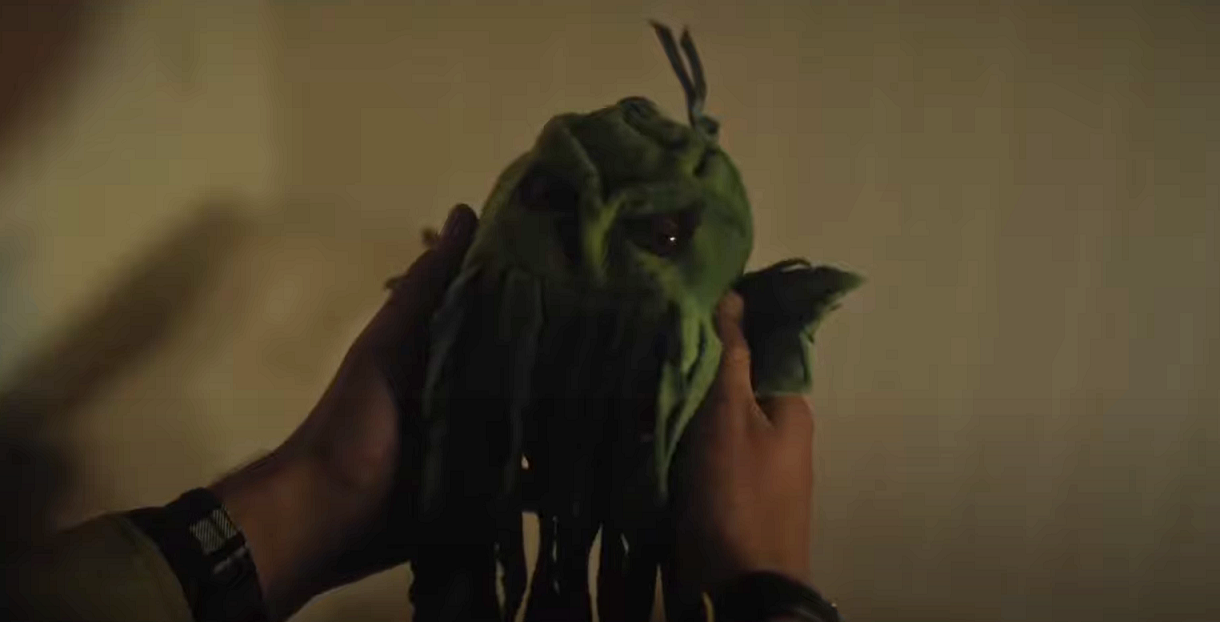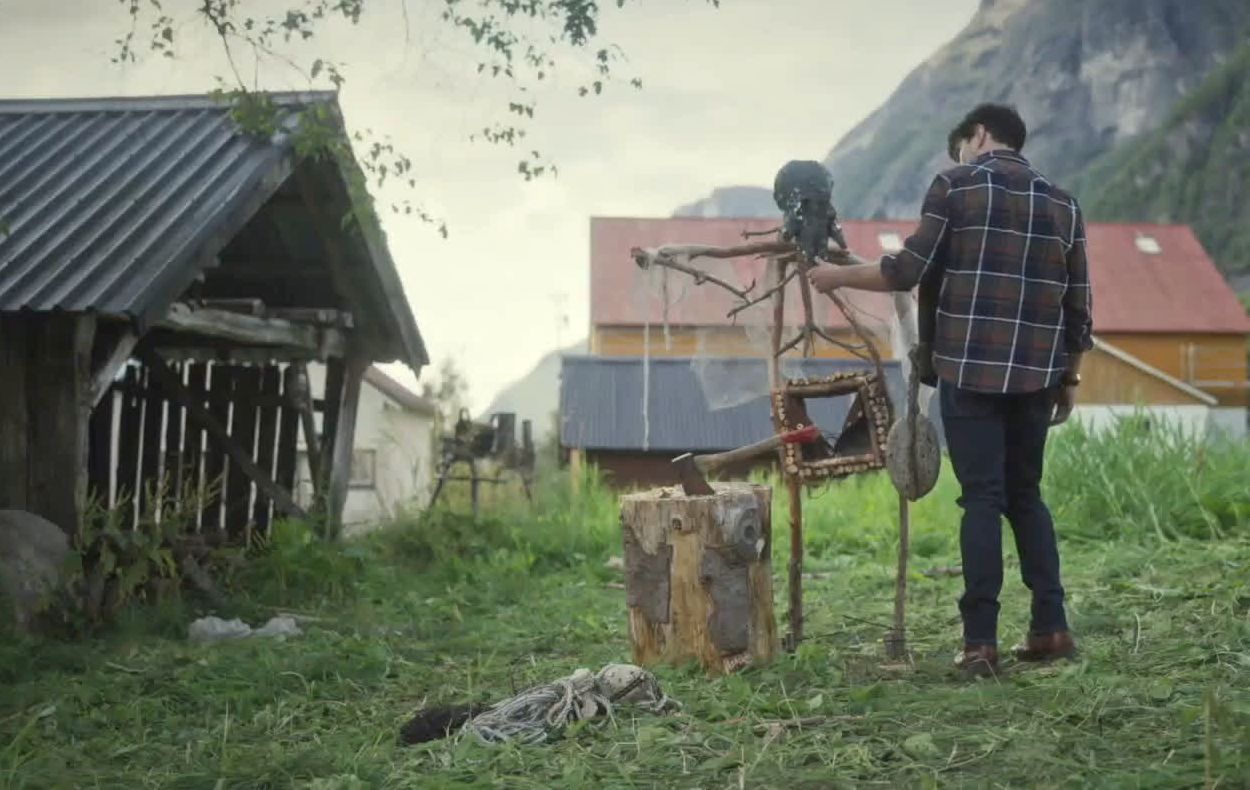A New Yorker and his pregnant wife travel to Norway, where he was born, to collect an unexpected inheritance. They find themselves in a living nightmare as they find themselves in a terrible cult that worships a sea-dwelling deity.
Sacrifice is not your average cult horror film about a man and his pregnant wife, Emma, going to Norway, where he was born. The two are purportedly there to deal with the man’s mother’s death when unexpected riches appear on their doorstep. However, they are engulfed in a nightmare as an ancient galactic terror emerges to claim its rights.
Sacrifice is a slow-burning film in which the cult’s strange effect on the couple slowly creeps into their daily lives. It may feel a little slower than necessary at times. Throughout these scenes, however, the film tries to interest the audience by adding visual components to the deity, or beast, that the peasants worship.
Sacrifice might also be considered a classic winter film. Foggy nights and calm vistas linger in the Norwegian town’s secrets, as does the smoke of warmth. The residents of this village are locked off behind a layer of friendly gestures. And, of course, the enigmatic seas, which remain still and stare you down.
n the distance, a gigantic mountain looms. The eerie, unnerving soundtrack serves as a reminder that this is not just any large mountain, but a massive, terrifying one. The eerie silence is broken by a boat plowing over the water. The depths of your aquatic reflections are hidden beneath the surface.
These depths are reflected in the peasants’ dreams or nightmares over there. The town’s motto, “dream well,” is a bit ambiguous when it comes to assimilating the town’s strange and eerie traditions, which have been practiced for decades. It is unmistakably a warning to the public. Dreams that recur at all hours of the day and night gradually turn into terrifying nightmares.
The general mood of the film was crafted in such a way that it was able to convey a sense of cosmic dread. It’s set on a real Norwegian island that features both gorgeous and terrifying landscape that seems like something Lovecraft would have imagined. The inclusion of scenery and its beautification gradually heightens the mood and tension, capturing the essence of the film that one could expect to see.

It’s a film with a broad landscape, tight roads, and very odd residents of a rural town on an island in western Norway’s northernmost regions. It’s dreary, wet, and chilly as usual. When the son who fled 15 years ago returns with his pregnant wife, you’ll notice that the house is constructed on a plot that seems to have a dark and evil past. The character of Isaac gradually becomes quite distressing.
At first, he and Emma appear to be a typical, young married couple. Still, as the film progresses, Isaac is profoundly influenced by the cult and its divinity. Isaac gradually develops an aberrant behavior, culminating in a terrifying, dramatic culmination. Yet, no clarification is ever presented about why Isaac is so captivated by the creature. His demeanor shifts far more abruptly than that of the cultists, and the shortage of explanations is aggravating.
When Isaac learns of his mother’s death, he discovers that he has inherited a house on the Norwegian island where he was born. He recalls that his mother abandoned the island with him when he was pretty tiny.
Thus, this mansion comes as a complete shocker to him. He and his very pregnant wife, Emma, plan to visit the island to sell the place as early as possible so that they may return to the States before Emma gives birth. When they get on the island, they unearth mysteries from Isaac’s history, including information regarding his dad’s death and his mother’s apparent participation in it.
The journey turns into a nightmare when they discover the locals are a cult that idolizes and worships a sea-dwelling monster or, in their words, a divinity. Over time, Isaac grows distant as he learns about his ancestors’ rites and traditions, while Emma, approaching her due date, gets frightened and plagued by nightmares. As they settle in, the truth about Isaac’s history emerges.
The horror moments which are generated are founded more on Emma’s fear about the scenario. Her dreams get increasingly spooky as the film progresses, as they help drive the film’s relatively rapid tempo and add to its strangeness. However, it becomes a little easier to pick up on when she’s dreaming – since it generally involves waters and tentacles while she’s doing monotonous tasks, though they are lovely aesthetically.
Almost every scene in this film, especially those involving blatant terror, is revealed to be a dream of our pregnant heroine. Imagination is the worst nightmare for a person in this town. The divinity or the creature usually makes its appearance in one’s imagination. As one focuses on how the characters develop throughout the story, the sea-dwelling God becomes apparent, controlling one’s mind, body, and soul. The control is established through the nightmares, the daydreams, the thoughts that engulf one’s fear and guilt.
The problem starts with a non-threatening quarrel in the local pub. They ridicule Isaac since they assume he is a typical American. Still, they become terrified when Emma discloses Isaac’s Norwegian surname. Even though Emma’s suspicions were raised, and she was weirded out, she dismissed them for the sake of it. The townspeople are competent enough, chiefly represented by Renate, the island’s sheriff, a pretty amusing cult leader, and recounts some fascinating stories in the film.
Renate arrives at their home unannounced. The local police chief shocks Isaac by informing him that he left the island 25 years ago; his history has altered and will have future ramifications. As the local policeman, she tells him, somewhat abruptly, that his mother murdered his father as an assumption and that his blood is on the floor beneath Isaac’s bare feet. She then invites them to supper. She introduces the pair to her extremely quiet local daughter Astrid. She describes how the people worship The Slumbering One, a local folk god of local lore.
Renate invites Isaac and Emma to an annual rite to learn about local customs. The ritual includes wearing hooded cloaks, pronouncing “thee” an alarming number of times in loud and respectful tones, and being quasi-baptized in the icy waters. Isaac suddenly joins Renate’s robed sect for their ceremony in the sea.
As Renate invites them to a neighborhood get-together, she’s throwing tomorrow, which is named something with many umlauts and k’s in it. Isaac is becoming more receptive to learning about Midsommar traditions and customs. Isaac’s conduct becomes problematic for Emma after reciting a promise to The Slumbering One and getting baptized during the rite. Emma and Isaac meet with realtor Matias to discuss the sale of their home.
Having been persuaded by Gunnar and Ledvor that he has discovered his true home, Isaac surprises Emma by stating that he refuses to let them leave. Emma informs Isaac that he has gone insane. When their dispute gets violent, Emma knocks Isaac unconscious and runs away. Before this, Emma is evidently irritated by Isaac’s stubbornness, as is Isaac’s apparent wish to stay in Norway and never return to the United States. They fight a lot, and he goes out and drinks with the locals, acting strangely and standing mesmerized beneath the aurora borealis.
Isaac and Emma quarrel a lot. He goes out to spend the evening with the locals. He acts erratically while standing mesmerized beneath the aurora borealis, watching Astrid rise from the freezing, cold water like a ghost, a phantom who was not even clothed at all. Suggesting the circumstances as strange would be an understatement.
The beautiful northern lights hold a dark belief among the locals. When it appears against the solid background of the night, rather than getting mesmerized, it scares them. And this fear adds to the mystery surrounding the town and its people.
Astrid has a peculiar way of approaching Isaac, which initially makes him uncomfortable. However, as she rises from the cold water, with the aurora borealis painting the background, it seems as if she has a profound impact on him, luring him into her aura and hypnotizing him. Astrid’s personality gives us a hint of the mystic powers surrounding the town’s community.
Throughout the narrative, Isaac’s loving character progressively loses his caring nature as he frees himself from his everyday surroundings, which adds to his character. He and Emma approach the circumstance and community differently, as Isaac gradually accepts this environment while Emma wants to return home. This interaction is best shown when Emma lightly mocks these people’s undoubtedly weird rituals.
Yet, it becomes very evident how uncomfortable she is. While Isaac may have giggled the day before, he now warns her that “it’s uncouth to insult someone else’s culture.” Emma is shocked and confused since this is nothing like the Isaac she has known for so long. The film’s title plainly indicates that a sacrifice would take place, and it was evident from the start who would be engaged.
Why is this so? That’s not so clear. Emma seeks to depart the island as quickly as possible after a brutal attempt to rescue her life from Isaac, who did not act like himself. However, her naiveté leads her to seek assistance from the wrong person. Emma awakens bound to an altar, surrounded by robed cultists. Isaac draws his sword and prepares to stab his pregnant wife in the stomach. Renate unexpectedly has the cultists kidnap someone else instead. Even while there is a sense of relief, the cult prepares an unbreakable trap for the newcomers.
With the legends of their deity in the sea, the society building on this island is captivating. The visual in this scene, with the paintings and spooky stuff strewn around, add to the plot. Lovecraft references are liberally scattered, including murmurs of “The Slumbering One” and Cthulhu sculptures. Much of the weirdness revolves around water, whether in baths, sinks, or the sea. Tentacles can be seen in visions and dreams. Pagans in white robes participate in full immersion baptism ceremonies and persuade Isaac to take the plunge.
“Sacrifice” was similar to “The Wickerman” in that they suspected these folks had a secret plan for bringing Isaac home. But what exactly is it, and why are they behaving so oddly? There were some imperceptible surprises along the way, but it really adds to the suspense and tension.
The idea appears to be a rip-off of Midsommar, yet it has individuality. In any case, the eccentric narrative, taken from a short tale by Paul Kane and influenced by the literature of HP Lovecraft, is reasonably good on the cultural tension between Americans and Europeans.
It taps into the reservoir of unsettling associations associated with horror stories situated in northern Europe, such as The Wicker Man and Midsommar. Sacrifice makes an essential contribution to the canon by introducing fears about a Nordic proclivity for insanity brought on by long nights, northern lights, aquavit, and too much skinny-dipping in frigid waters.
Cult films are typically peculiar, unusual, wacky, unconventional, bizarre, or whimsical, with crazy, strange, distinctive, and gimmicky characters or stories, as well as flashy settings. They are frequently seen as problematic because they deviate from typical narrative and technical standards.
They can be highly stylized, and they are often faulty or odd in some manner. Most cult films transcend several film genres, such as science fiction, horror, melodrama, and so on. In contrast, some film genres, such as horror or sci-fi, are more prone to cultish. Sacrifice attempts to distinguish itself from other cult horror films with its Lovecraftian overtones.
The film’s title clearly leads us to expect a ritual that serves as a sacrifice to renew power—this expected notion kind of guides us to a predictable outcome. The mysterious and creepy vibes, the absurd ways of interacting, and the bizarre beliefs and practices are depicted in a land of mist and watery landscapes. This landscape sets the stage for a classic cult movie; however, it molds itself in its unique form.
“Sacrifice” inserts exceptionally brief bursts of blood and tentacles to keep the viewer’s pulse from deadening owing to the conversational dullness and depressing tone. In each of these cases, the panic is revealed to be a hallucination of some kind. “Sacrifice” most likely holds the dismal record for the most egregious usage of the “suddenly awakened from a nightmare” cliche in a single film. When an allegedly terrifying screenplay relies so heavily on transitory visions to fake frights, it’s easy to tell that the plot lacks the depth to perform the heavy work as horror.
It’s nice to see Barbara Crampton, the horror princess of the 1980s, still thriving. Barbara Crampton is a horror icon. Her iconic combination with Jeffrey Combs in one of Stuart Gordon’s major works quickly endeared her to genre cinema lovers. Subsequent performances in another significant Lovecraft adaption, cult favorites like “Chopping Mall,” and a slew of hilarious Full Moon films paved the way for her well-deserved icon status.
Barbara Crampton featured in several HP Lovecraft adaptations in the 1980s and 1990s, including 1985’s Re-Animator and the following year’s From Beyond, both directed by the late Master of Horror Stuart Gordon. Now, the actress has returned to HP territory with Sacrifice, a film that, while inspired by Paul Kane’s short tale “Men of the Cloth,” has a decidedly Lovecraftian feel.
Norway has rich Norse mythology as well as numerous folk stories. Most individuals have at least a rudimentary understanding of Norse mythology, even if they simply know Thor, Odin, and Loki! However, Norse mythology and folklore are much more than the Norse Gods. There are several rural stories about trolls and their shenanigans.
Of course, occurrences of the aurora borealis sparked rumors for centuries before scientists explained. Norse mythology is an essential aspect of modern culture in the English-speaking world. No one knew anything about it outside of the Nordic region until the nineteenth century. Surrounded by vast water bodies, various folk characters in Norse mythology originates from the waters, gaining their powers.
The film does a fantastic job of portraying the regional tradition and mythology with the rural artwork and handicrafts. However, there is a lack of awareness of Norwegian culture, mainly when presenting the style of speech or the human relationship. The projection has the potential to be more accurate. They have just too many Norwegians in the cast to let this go. The way they converse and interact makes the film seem realistic or relevant.
The monster

Tentacled toys and artwork may be found in stores as well as Isaac’s childhood bedroom. This may be a crude manner of hinting at its existence. Still, it also acts as a continual reminder of the entity’s absolute authority over the island. It’s always there, lurking in the shadows. Despite the movie’s many allusions to the creature, there is a distinct lack of natural appearance.
It, or rather its tentacles, only appear a few times. This is particularly noticeable during Emma’s dreams. These are, without a doubt, the most terrifying parts of Sacrifice. Her nightmares become more distressing, with her being the victim of horrifyingly horrific atrocities frequently committed by the entity’s tentacles. The rest of the film concentrates on the villagers and the cult itself rather than the beast. As a result, there are few terrifying scenes outside of Emma’s dreams.
Why you should watch Sacrifice?

Inspired by Paul Kane’s short novel “Men of the Cloth,” “Sacrifice” follows Isaac and his wife Emma as they face tepid Cthulhu-related shivers. Isaac has no recollection of escaping with his mother from a small Norwegian fishing community 25 years ago. But he’s returned to collect his inheritance, so you know family secrets will hamper the couple’s journey.
Because Emma is pregnant and the village looks to be filled by cultists, you can bet her unborn child will play a role in someone’s diabolical scheme, because where else can a simple premise go except somewhere we’ve gone umpteen times before? “Sacrifice,” billed as a Lovecraft-style horror film, doesn’t accomplish anything as epic as actually showing a monster or much of anything for that matter. Scenes are mostly made up of talking, some walking, and more talking.
On the sides of a couple of frames, smoky fog drifts in. The problem is that you can tell it’s from a smoke machine. Violet and other rich colors are used to highlight dreamlike design concepts. It’s only that, unless Norwegian villages paint their homes like a scene from “Suspiria,” such lighting is rarely inspired by a practical plan.
The psychological anguish of Emma appears to be the primary emphasis of Sacrifice rather than the cult and its hold upon Isaac. For all intents and purposes, she is the film’s true protagonist. With her horrific nightmares and Isaac’s increasingly bizarre behavior, it’s easy to sympathize with her and her desperate need for freedom.
The fact that Isaac isn’t especially friendly, to begin with, makes empathizing with Emma extra simpler. He comes out as entitled from the start of the film; he arrives in Norway and expects to be accommodated by the natives, although making little effort to adjust himself. As a result, Emma is the only character who is simple to cheer for, and it’s difficult to care what happens to Isaac.
The plot is riddled with holes. Sacrifice attempts to distinguish itself from other cult horror films with its Lovecraftian overtones. Still, there isn’t enough Lovecraft, or creativity, for it to truly stand out. Overall, the film does carry you along, but it does so slowly. On the other hand, you would like it if you stayed until the finish.
